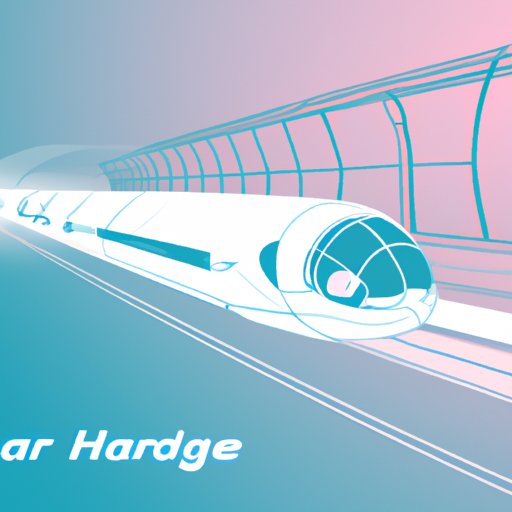Introduction
In recent years, the global transportation industry has been undergoing a radical transformation. With the advent of new technologies such as autonomous vehicles, artificial intelligence, and high-speed travel systems, the way we move around is changing rapidly. This article will explore the next major innovation in transportation technology and examine the potential benefits and challenges that come with it.
Exploring the Latest Developments in Transportation Technology
The rise of new transportation technologies has been a hot topic of conversation in recent years. The three main areas of development are autonomous vehicles, artificial intelligence, and hyperloop and other high-speed travel technologies. Let’s take a closer look at each of these.
Autonomous Vehicles
Autonomous vehicles (AVs) are self-driving cars that use sensors and software to navigate the roads without any human input. AVs are becoming increasingly popular due to their potential to reduce traffic, improve safety, and reduce emissions. However, there are still some roadblocks to widespread adoption, such as regulatory issues, public acceptance, and technological limitations.
Artificial Intelligence
Artificial intelligence (AI) is being used in a variety of ways to revolutionize the transportation industry. AI-powered mobility solutions are allowing us to optimize routes and predict traffic patterns, while also providing real-time data on road conditions and driver behavior. In addition, AI can be used to automate certain aspects of the driving experience, such as parking and lane-changing.
Hyperloop and Other High-Speed Travel Technologies
Hyperloop is an advanced form of high-speed travel that uses magnetic levitation to transport passengers and cargo in capsules through a vacuum tube at speeds of up to 700 mph. Other high-speed travel technologies, such as maglev trains and supersonic aircraft, are also being developed to reduce travel time and improve efficiency.
Examining the Future of Transportation: What’s Next?
As more and more advances are made in transportation technology, it’s clear that the future of travel will be drastically different than what we have today. Let’s take a look at the potential benefits and challenges associated with the three major transportation innovations.
Benefits of Autonomous Vehicle Technology
Autonomous vehicle technology has the potential to revolutionize the way we move around. AVs could significantly reduce traffic congestion and improve road safety by eliminating human error. They could also reduce emissions and make transportation more efficient. Additionally, they could enable us to use our time in the car more productively, as we wouldn’t need to focus on driving.
Potential Impact of Artificial Intelligence
AI-powered mobility solutions could help us make better decisions about how to get from point A to point B. AI could also provide real-time data about road conditions and driver behavior, enabling us to adjust our routes accordingly. In addition, AI could automate certain aspects of the driving experience, such as parking and lane-changing, making the process faster and easier.
Benefits of High-Speed Travel Technologies
High-speed travel technologies, such as hyperloop and maglev trains, could significantly reduce travel times and make long-distance trips more efficient. They could also reduce the need for air travel, which would result in fewer emissions and a smaller carbon footprint. Additionally, these technologies could create jobs in the transportation industry and stimulate economic growth.

A Look Into the Innovative Technologies Transforming Travel
Now that we’ve explored the potential benefits and challenges of the three major transportation innovations, let’s take a closer look at each one. How are these technologies currently being used, and what do they have to offer in the future?
Autonomous Vehicles: The Revolutionizing Technology of Tomorrow
Autonomous vehicles are already being tested in many cities around the world. While the technology is still in its early stages, it has the potential to completely revolutionize the way we move around. AVs could reduce traffic, improve safety, and reduce emissions by eliminating human error. They could also enable us to use our time in the car more productively, as we wouldn’t need to focus on driving.
Advantages of Autonomous Vehicles
- Reduce traffic
- Improve safety
- Reduce emissions
- Allow us to use our time in the car more productively
Current Roadblocks to Widespread Adoption
- Regulatory issues
- Public acceptance
- Technological limitations
How Artificial Intelligence is Changing the Way We Move
AI-powered mobility solutions are providing us with the ability to optimize routes, predict traffic patterns, and provide real-time data on road conditions and driver behavior. AI could also be used to automate certain aspects of the driving experience, such as parking and lane-changing. In addition, AI could help us make better decisions about how to get from point A to point B.
Benefits of AI-Powered Mobility Solutions
- Optimize routes
- Predict traffic patterns
- Provide real-time data on road conditions and driver behavior
- Automate certain aspects of the driving experience
- Help us make better decisions about how to get from point A to point B
Challenges Facing AI’s Widespread Adoption
- Cost
- Data privacy concerns
- Regulatory issues
- Public acceptance
The Potential of Hyperloop and Other High-Speed Travel Technologies
High-speed travel technologies, such as hyperloop and maglev trains, could significantly reduce travel times and make long-distance trips more efficient. They could also reduce the need for air travel, which would result in fewer emissions and a smaller carbon footprint. Additionally, these technologies could create jobs in the transportation industry and stimulate economic growth.
Benefits of High-Speed Travel Technologies
- Reduce travel times
- Make long-distance trips more efficient
- Reduce the need for air travel
- Create jobs in the transportation industry
- Stimulate economic growth
Current Limitations of High-Speed Travel Technologies
- High cost of construction and maintenance
- Environmental impact
- Safety concerns
Conclusion
The transportation industry is undergoing a rapid transformation, with new technologies such as autonomous vehicles, artificial intelligence, and high-speed travel systems emerging every day. Autonomous vehicles have the potential to reduce traffic, improve safety, and reduce emissions, while AI-powered mobility solutions can help us make better decisions about how to get from point A to point B. Finally, high-speed travel technologies could significantly reduce travel times and make long-distance trips more efficient. While these technologies all have the potential to revolutionize the way we move around, they also come with their own set of challenges, such as cost, data privacy concerns, and public acceptance. As these technologies continue to develop, it will be interesting to see how they will shape the future of transportation.
(Note: Is this article not meeting your expectations? Do you have knowledge or insights to share? Unlock new opportunities and expand your reach by joining our authors team. Click Registration to join us and share your expertise with our readers.)
